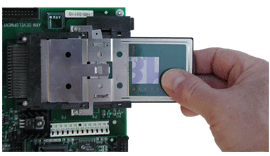FAT Compatible File System
The filesystem is a set of processes which together form an interface to FAT filesystems on physical drives. The interface is compatible with SCIOPTA device driver model.
Our FATFS/SafeFATFS infrastructure offers user application a unified interface to access multiple types of mediums with multiple partitions on them, in parallel. It also allows raw access to sectors on these mediums also using the same unified interface. Raw accesses can be done to entire disk or to a single partition on a disk, while another partition is mounted as FATFS filesystem.

SafeFATFS FailSafe FAT File System
Additional feature to the standard FATFS, SafeFATFS is enhanced to offer power-fail protection.
FATFS SCIOPTA FAT File System
Advanced fully featured FAT12, FAT16 and FAT32 file system for embedded systems with long filenames; caching options, Unicode support, drivers for Compact Flash, MMC, SD cards, HDDs, NAND Flash and Serial Flash.
Features

Media Types
MultiMedia Card and Secure Digital Cards
This is probably the simplest method to add a DOS compatible file media to your embedded device. We provide a range of drivers for interfacing to SD and MMC cards including standard SPI implemented in either hardware or software. We provide hardware design information for implementing this.
Hard Disk Drives
Sample Driver and reference designs have been created for interfacing an IDE HDD to a FAT file system. Also provided in the file system are caching options which are essential when using a HDD.
The caching mechanisms combined with the efficiency of SFATFS and its mainly zero-copy reads and writes gives the best possible performance when implementing a HDD on an embedded system.
RAM Drive
A RAM drive is provided as standard and is particularly useful in getting a system up and running without any hardware dependencies.
Compact Flash Cards
Compact Flash cards require a more complex communication with a PC compatible media but offers performance advantages because of the wider data bus thus generally a higher throughput is achieved and in many cases a reduced CPU load. We also provide hardware design information and CPLD logic where appropriate.